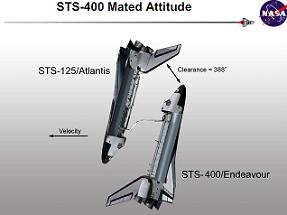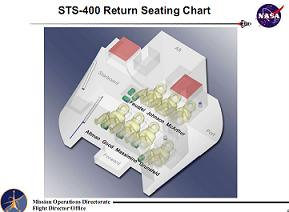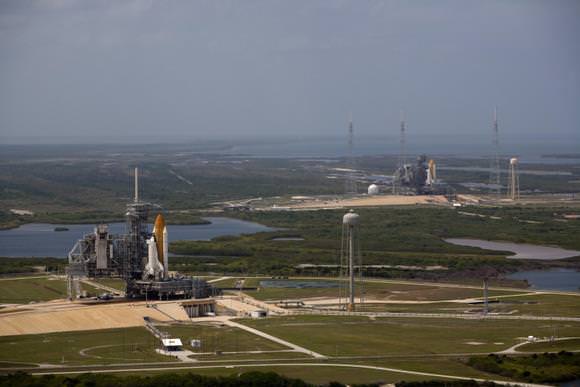[/caption]
Two space shuttles now sit out on the launch pads at Kennedy Space Center: Atlantis on 39A for the much anticipated Hubble Repair mission, scheduled to launch on May 12. Over on 39B sits Endeavour, which made the slow journey there early on Friday and she is now poised for the STS-400 LON (Launch On Need) Mission, a mission no one hopes will happen. This would be a mission to rescue the crew of Atlantis should the shuttle be struck by debris – either during launch or during the mission (read more about the risks of debris hit during the Hubble Mission). If STS-400 were necessary what would actually happen?
In the situation where Atlantis and the crew are not in immediate danger, but, for example, the shuttle’s thermal protection system (heat tiles) were compromised from debris hit (from insulating foam from the external tank like Columbia was, or space debris) and the shuttle would be unable to land safely, Endeavour would be launched at a specific time and inclination in order be able to rendezvous with Atlantis. The rescue flight would last 8 days and go as follows:
Once Endeavour and her four-person crew reaches orbit, the preparations for rendezvous with Atlantis would begin. Unlike all previous post-Return to Flight missions, the crew would not perform the standard Thermal Protection System inspection on Flight Day Two, but instead by done after the STS-125 crew was rescued.

Endeavour would rendezvous with Atlantis the day after launching from the Kennedy Space Center. The two space shuttles would then approach each other payload bay to payload bay, at a 90-degree angle, about 44 ft apart. Endeavour’s robotic arm would grapple the orbital boom system on Atlantis. After Endeavour successfully grapples Atlantis, Endeavour would take attitude control of the “stack” of the two shuttles.
Then, comes the most interesting – and dangerous – part. Spacewalkers from Endeavour would do one space walk on Flight Day 3 to string a tether between both shuttles. On Flight Day 4, they would conduct two spacewalks to retrieve their colleagues from Atlantis.
Once Atlantis’ crew is safely aboard the rescue orbiter, Endeavour’s crew will maneuver the two vehicles to provide the right separation, which would occur during daylight so the crew could watch for any problems.
Atlantis would be released and be commanded from the ground to do deorbit and landing maneuvers and likely crash into the Pacific Ocean.

On Flight Day 5 the dual crew would inspect Endeavour for damage, and if all was well, land on Flight Day 8.
Astronaut John Grunsfeld, one of the four spacewalkers who will fly on Atlantis, says keeping the Hubble telescope flying is a mission worth the risk.
“When you think about risk, it is all relative to what is the reward, and I think in the big picture Hubble is something that I certainly feel is worth risking my life for because it is about something that is so much bigger than all of us,” Grunsfeld said. “It is about science, it is about inspiration, it is about discovery. It is about all the kids who will look at the Hubble images and dream.”
Source: NASA Spaceflight.com


This is quite an interesting plan to read about. I think it is a great idea and have to wonder why this wan’t done for previous missions where the ISS could not be used for sanctuary. Of course had the shuttle been designed better from scratch none of this would be necessary. As I understand it the Orion crew vehicle has built in safety features which would make this kind of effort unnecessary when it launches.
Atlantis is on pad 39A and Endeavor on 39B. You mixed them up in the story. Everything is in the details… 😉
The mission would be unprecidented.
Not counting the iss, the last (only?) time nasa had two of own spaceships in orbit would haveback in the Gemini days. Which was a flyby , not a rescue.
It’s the kind of mission you’d expect a shuttle could do, but it’s on the edge of the orbiters ability.
We should have spent the last 37 years worth of money and time concentrating on the moon and Mars mission like we are now. We would certainly already BE there by now, given the fact that it took less than ten years to get to the moon.
What a waste of momentum!
1. Why would the astronauts from Atlantis need to be “retrieved” by the Endeavour crew? That seems more dangerous than simply letting the Atlantis crew make the spacewalk by themselves.
2. If they find unrepairable damage on Endeavour, then what? There’s no way they could get Discovery in the air for an “STS-401/STS-400B” rescue, is there? Especially waiting until day 5 to do the inspection. I’d think they’d want to know that as early as possible. I realize they’d still need the day 5 inspection for possible micrometeorite damage, but history has shown (albeit the situation has changed since the “train-wreck in space”) that launch damage is a higher probability. Would 3 extra days make any difference WRT getting Discovery aloft? Could Discovery hold three (well, 2-1/2, I guess) crews in an Apollo 13-level emergency?
What a painful, tragic, and expensive disaster the Shuttle program has been…I so hope all involved (starting with Congress, of course) have learned a LOT of lessons. It’s the Acme parachute of spacecraft, straight out of a ‘Roadrunner’ cartoon.
Greg:
> I think it is a great idea and have to wonder why this wasn’t done for previous missions where the ISS could not be used for sanctuary.
They have, on over a dozen (not sure about all) post-Return-to-Flight missions:
http://en.wikipedia.org/wiki/STS-3xx
I presume the flight designator reflects the fact that this mission isn’t going to the ISS.
Nancy, while looking this up, I answered my own 1st question above (I think): not enough EMU’s on-board the stricken vehicle (and possibly inadequate room on the rescue ship for all that gear?).
Lastly, 1:200 is a reckless number (albeit the best they can apparently do). When the Shuttle was in the design/build stage, the plan was for up to 25 flights annually, IIRC. I believe each orbiter was expected to be capable of 100 or more missions. IOW, at 1:200, the statistical probability of a LOCV over the course of the program would’ve been considerably higher than 50%. NOT acceptable. With a money or dog, maybe, but not with 7 humans.
Nancy, thanks for your article on this subject. This is the first story I’ve read on the details of the(hopefully unnecessary) rescue mission. BTW, any links to a larger version of the above picture? @ Max: The Gemini missions you’re referring to were rendezvous missions, not flybys. These missions plus Gemini missions that involved docking with an unmanned vehicle set the stage for later rendezvous & docking techniques needed for the Apollo missions. @Keith A: I would think by now tens of thousands of engineers (both within NASA and private contractors) have looked at all aspects of the rescue mission. I suspect the reason for rescuing the crew on day 3 results from dwindling supplies on Atlantis and to get the astronauts off ASAP. Tile inspection can wait till day 5 because Endeavour will have additional supplies of consumables to allow for a longer mission with additional passengers. As for the Shuttle program itself, I prefer to focus on all successful missions that have given us invaluable scientific & technological knowledge (i.e. HST, Chandra Xray Observatory, Compton Gamma-ray Telescope, Galileo etc.) The men and women who fly and work with these vehicles know full well the risk they’re taking. I applaud all those dedicated, hardworking & brave astronauts.
Jon
I put the link to the top image at the bottom of the article.
Thanks nobody for noting my error
Jon –
I certainly hope you aren’t implying I was taking ANYTHING away from the astronauts that fly these missions. The only thing I wanted to be as a kid was an astronaut. I graduated from HS in 1974 – the Shuttle would’ve been what *I* would’ve flown had I realized my dream.
The program has been a total failure at accomplishing ANY of its design goals:
It hasn’t lowered per-lb launch costs; hasn’t given anywhere near the turnaround capability it was designed for. Much of what it’s capable of is possible with unmanned missions.
It’s also stolen time and money from ADVANCING space science. Apollo went to the MOON. The Shuttle can’t even achieve GEO! We could’ve spent this time and money building something to go to MARS.
http://en.wikipedia.org/wiki/Criticism_of_the_Space_Shuttle_program
See the “Shuttle Operations” section:
> Because loss of crew is unacceptable
That’s NASA talking.
“Cultural Issues”:
> Recommendations such as “think like a manager and not an engineer”, aired at a video conference before the 1986 launch of Challenger, a “normalized deviance”, which can be best described as a decrease of resources and emphasis given to safety at the expense of on time launches.
> In addition, the physicist Richard Feynman, appointed to the official inquiry on Challenger, published a personal statement as an appendix to the official report in which Feynman said that in some ways, NASA was trying to repeal the laws of nature in its aggressive launch schedules.
A PERSONAL statement.
There’s an old saying amoungst soldiers: “There are a LOT of ‘brave’ men – in graves.” Aviators: “There are bold pilots, and there are old pilots, but there are VERY few old, bold pilots.
I was a skydiver for 13 years. Aviation is all about MANAGING risk. The only “security” that exists is false security. Risk avoidance is not possible; risk management is how non-bold pilots grow old. I knew every time I stepped out that door I might be dead in 2 minutes. That’s what makes the sport so rewarding – knowing you’re competent, prepared, and HAVE A PLAN B. ALWAYS. I logged 3200 jumps in my career. If the risk of dying in the sport were 1:200, the sport would not exist. Period.
Darned tooting the astronaut corps is brave and dedicated – they have not only my ultimate admiration, but also envy. it’s NASA MANAGEMENT that needs to be tossed in the garbage. Engineers (especially at Morton Thiokol) BEGGED NASA not to launch Challenger on its ill-fated final mission – for the very reason that caused the LOCV. NASA management placed a higher priority on launch schedules than on the lives of 14 astronauts. Mercury, Gemini, Apollo – 3 dead over all that time (and they died while training).
Of course it’s going to be “dangerous” – so is driving a car. 1:200 with 7 humans on-board IS NOT ACCEPTABLE. That statement has NOTHING to do with the astronauts – it has to do with their bosses (and a Congress wanting Space Prestige on the cheap).
I agree completely that the accomplishments the program has achieved are to be applauded; we’ve seen unbelievable returns, from HST and Chandra, alone. With sane management, we’d also still have 14 heroes – ALIVE.
a VERY COMPLEX and NEVER TESTED BEFORE rescue operation that adds VERY MUCH RISKS to an already VERY RISKY mission, as explained here:
http://www.ghostnasa.com/posts/044sm4risks.html
If BOTH shuttles are damaged on their takeoffs, then they can dock with the ISS. There should be enough resources for everyone on both shuttles and the ISS while ground control figures things out.
It’d be cramped, but they could also conserve the first damaged shuttle with a skeleton crew in case they need the systems on it.
Oh, I’m aware they may only be one shuttle dock on the ISS – not sure) they can still use the arm to grab the one shuttle in theory.
@Max: You’re forgetting all of the Apollo missions that involved two separate spacecraft, the command/service module and the lunar module (9 through 17 except for 13).
@Kevin F.: The whole point of this rescue mission is that they CAN’T dock with the ISS because it’s in a very different orbit. If they could dock with the ISS, there would be no need for the rescue shuttle being discussed here.
@ToSeek:
Good point. Although both of the ships in those missions rode up on the same rocket in a single launch.
What they learned in Gemini 6 was that making rockets go on schedule (with Gemini 7 waiting in orbit while 6’s pad sat in tatters and the rocket itself showed malfunctions) can be a tricky and dangerous business.
…and that was with a system that had a decent record for flying on schedule.
We should call the maneuver, the Kobayashi Maru.
@ Keith A: I have no qualms with most of your statements. I graduated high school in 1976, so I had similar aspirations. No slight was intended towards your sincere concern with problems within the Shuttle program or the astronauts involved. I, too, deeply regret the loss of precious human life in the history of the Space Shuttle program. My point was that a small number of Shuttle missions remain on the docket. Regardless of the past successes or failures of past missions, very few remain, so let’s look forward to more sensible, experience-based options when it comes to manned spaceflight. These astronauts did not perish in vain! Let’s learn from our past mistakes and move forward with manned space exploration.
Keith A Says:
April 18th, 2009 at 4:23 am
[…]
I logged 3200 jumps in my career. If the risk of dying in the sport were 1:200, the sport would not exist. Period.
[…]
The probability of you surviving that many jumps with that probability of death is about 1 in 10 million!
@Jon –
Thanks for the reply, and sorry I’ve been away all day. We’re on the same page; I get your point as well and agree that the small number of missions left are worth the risk. It’s all good. 🙂 Sorry if I came on a bit strong.
@McRude –
Amen.
Max
Don’t forget the lunar launches of apollos 11-17 (-13). Tges have to be classed as independent launches in this discussion!
Adam
why waste the resouce of crashing the damaged shuttle??? Couldn’t we fly it to the moon and park it for future use?
seems like a waste of lbs we could use some other time without having to give it up…even if it had to crash on the moon we would still have some resources there to use in the future
You say the two shuttles end up 90 degrees, but the picture seems to show them 180 degrees (inverted) and 180 degrees (aft to fore)…
not to mention claiming insurance, but also the movie deals would roll in!
“As I understand it the Orion crew vehicle has built in safety features which would make this kind of effort unnecessary when it launches.”
Ares/Orion obviously can’t have foam falling from a non-existent external tank can’t hit a non-exposed re-entry surface. If that’s what you mean by a ‘safety feature,’ well okay, I guess…
That doesn’t mean other things can’t conceivably go wrong with it.
“It hasn’t lowered per-lb launch costs; hasn’t given anywhere near the turnaround capability it was designed for. Much of what it’s capable of is possible with unmanned missions.”
Yes, yes and maybe.
“It’s also stolen time and money from ADVANCING space science.”
You can’t know if more would have been spent on that, in the absence of the Shuttle.
“Apollo went to the MOON.”
Completely throwing away a launcher, every time.
“The Shuttle can’t even achieve GEO!”
Right. So? That was never the point. It *did* deliver stuff to LEO that could go on to GEO and interplanetary destinations, then return to Earth to do it again. Shuttle economics were bad, but the basic idea was perfectly rational. We still need reusable systems that can do this.
“It is about science, it is about inspiration, it is about discovery. It is about all the kids who will look at the Hubble images and dream.”
‘Do it for the children!’ Give me a freaking break.
With all the money spent servicing that telescope, they could have built a much better and more sophisticated telescope to replace the Hubble, (even better than the Webb) something that would have enhanced the dreams of the children, is less risky and doesnt cost any more of our children’s money, since they are going to build the Webb space telescope anyway.
Go ahead, count all the money from all the servicing missions, and factor in the risk to the astronauts lives as well.
..for the children.. Get real.